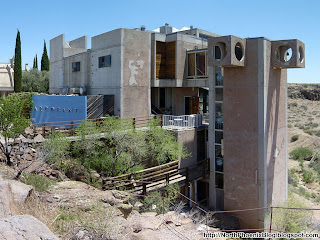I am very sad to report that notable Italian architect and Arizona resident Paolo Soleri has passed away on Tuesday, April 9th, 2013.
He died of natural causes at the age of 93.
Paolo Soleri was more than just an architect, he was a creative thinker, an artist, a father, a husband, a writer, and so much more. It's a real shame that more people haven't heard of him.
Although he is most well known for his architecture, Soleri wasn't a very prolific builder. Compared to Frank Lloyd Wright whose name is attached to over 400 structures, Soleri's completed projects are few and far between.
He designed a ceramics factory in Italy, a private residence in Cave Creek, the band shell ampitheatre at Glendale Community College, and a few other small projects. His only bridge was completed in Scottsdale in 2010.
Unlike Wright, the focus of Soleri's life was not on becoming a successful commercial architect. He was focused on developing a concept he called arcology. This is a portmanteau of architecture and ecology. Soleri studied in fellowship with Wright for a year and a half starting in 1946, and my guess is that his arcology idea probably began to germinate during this time.
Frank Lloyd Wright had the idea that buildings should be built with their specific environment in mind. He centered most of his designs around a philosophy he called "Organic design" which bridged the gap between architecture and environment. His Taliesin West school is a perfect example.
Wright bought a huge chunk of land outside the city at the base of the McDowell Mountains to build his Taliesin West school.
Taliesin West uses locally-sourced stone in the walls and sand from washes as part of the masonry. The Cinema Room is built partially underground for natural insulation from the earth. The walkways are covered with a durable canvas material to prove shade. This building was specifically designed for the desert, and its design would not be well suited to a coastal or mountainous climate.
Like Wright, Soleri also hated sprawl. In 1970, he bought 4,060 acres of land in Cordes Junction, 65 miles north of Phoenix. It was here that he began building the project that would consume the rest of his career: Arcosanti.
Although Soleri purchased thousands of acres of land, he designated only 25 acres for building with the remainder set aside as a preserve. Funding for the project came from the sale of bronze-cast wind bells and private donations.
So what exactly is Arcosanti? It is a vision of a new type of city that is dense, human-scale, and ecologically friendly. It is a model for a futuristic city, one that would avoid the problems that face Phoenix as we know it today.
A major metropolitan city like Phoenix has massive sprawl. There are countless subdivisions of single-family homes, connected by freeways. As the city expands outward its problems of traffic, pollution, and mass transportation become worse.
Soleri envisioned a walkable city with a minimal footprint on the desert. He sketched blueprints for massive, multi-use buildings where people could live, work, shop, and play. The efficient use of space was a guiding principle in his work.
In this illustration, Soleri has designed a high-rise tower called a Hyper Building. The 1,000 foot tall structure is divided into 8 zones, or "Terras." The mixed-use building would offer multiple floors of residential space, commercial office space, entertainment and retail, as well as levels for facilities such as water treatment and electrical generation.
There would always be somebody present in the Hyper Building concept. You would not have the mass migration of people leaving downtown at the end of the day to commute back to the suburbs. Ever been to downtown Phoenix on a weeknight? It's like a ghost town! Soleri thought this was not an efficient use of space to build these massive skyscrapers that sit empty and unused for half the day.
Imagine how different Phoenix would be if we had started constructing hyper-buildings in the 1970s. Imagine a major metropolitan city without 700 square miles of sprawl, a greatly reduced heat-island effect, less pollution, and a viable mass transit system.
Imagine a walkable downtown, a city that's not a maze of freeways interspersed with championship golf courses and master planned subdivisions of energy inefficient cookie-cutter homes.
Although his experimental city never grew to the size he had hoped, Arcosanti is not a failure in my eyes. It is a reminder that there is more than one way to build a city. Instead of criticizing Phoenix for its faults, he set out to lead by example.
The genius of Soleri was that he was green before "green" was a thing. Today we have architects winning awards for LEED certified buildings made of recycled crap. That's all well and good, but he was thinking about sustainability decades before it became popular. His visionary ideas were far ahead of their time.
We will miss you, Paolo!
Rest in Peace
1919-2013
Subscribe to:
Post Comments (Atom)




No comments:
Post a Comment